
Horsetail, Equisetum : planting, cultivation and care
Contents
Horsetails in a nutshell
- Horsetails are essential for their striking, architectural form
- They produce superb upright, sturdy stems
- They develop beautiful shades, from light, luminous green to dark green
- Horsetails are perennial, vigorous plants that require little maintenance
- They are ideal at pond margins or in containers on a patio
A word from our Expert
Horsetails are perennial plants admired for their upright, very vertical stems, which emerge directly from soil. Their stems are sturdy and hollow, and take on beautiful shades, from dark green, sometimes bluish, to fresh bright green. They add a lot of structure to a garden. Like ferns, horsetails are very ancient, primitive plants that have endured through time to reach us. They have the special characteristic of not producing flowers or seeds.
Horsetail is also a medicinal plant with many benefits (remineralising, diuretic, wound-healing…), which can be used as an infusion, juice or capsules. Additionally, in garden it is useful for making manures or decoctions, effective against fungal diseases.
Horsetails are very vigorous plants that do not really need attention and are not susceptible to diseases or pests. They are therefore very easy to grow. The only precaution to take is to contain them to prevent them becoming invasive. It is enough to plant them in a container, or to install a rootstock barrier.
Horsetails are ideal for planting around pond margins. They create a very natural scene when planted alongside ferns, reeds, Iris… They also work very well in modern, graphic gardens, as well as in Japanese-inspired planting beds. Finally, horsetails can easily be grown in a pot or container. In this way, they adapt very well to small gardens!
Description and botany
Botanical data
- Latin name Equisetum sp.
- Family Equisetaceae
- Common name Horsetail
- Flowering absent
- Height between 15 cm and 1.5 m
- Exposure full sun or partial shade
- Soil type moist, even waterlogged
- Hardiness generally between -15 and -20 °C, sometimes lower
Horsetails are perennial plants with rootstocks, very characteristic for their long erect stems, vertical, particularly striking. They are plants of wet ground, which favour waterlogged soils. There are about 25 species, found mainly in temperate regions of northern hemisphere, notably in Europe, Asia and North America.
Horsetails are very close to ferns, although these plants do not look very similar at first sight. They belong to group Pteridophyta, which includes ferns and other plants sharing the same mode of reproduction. Their origins are very ancient, since they existed before emergence of flowering plants. Horsetails reached their height of development in Carboniferous, about 350 million years ago. Those that persist today are true living fossils.
In France, in wild, 13 different species are found. In natural state they can form large colonies. They grow notably in ditches, marshes, on lake margins, in wet meadows and hygrophilous fallow land… Generally, horsetails can tolerate about 10 cm depth of water, but do not withstand complete submergence.
As horsetails grow naturally in France and originate mostly from temperate zones of northern hemisphere, they have advantage of being fairly hardy, well adapted to our climate. Equisetum hyemale, for example, can tolerate down to −30 °C!
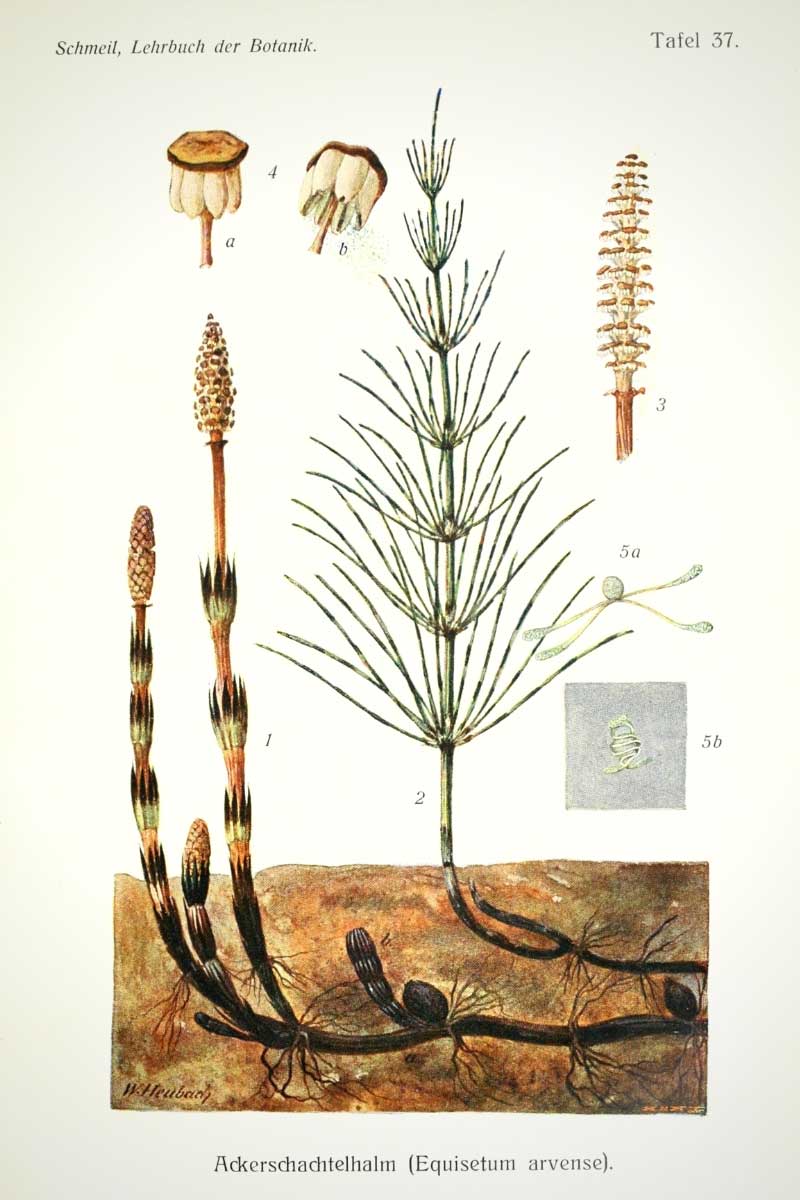
Equisetum arvense: Botanical illustration
Horsetails belong to family Equisetaceae, and to order Equisetales, from which they take their name. They are only surviving plants in this family (and in this order), other genera being extinct. In Carboniferous there were tree-like Equisetales, such as Calamites, giant horsetails that formed true trees exceeding 10 m in height!
Name Equisetum comes from Latin Equus: horse, and Seta: hair, bristle. In English, horsetails are called Horsetail: horse’s tail, and it is true that branched species, with their bushy aspect, can evoke a horse’s tail. Species name hyemale comes from Latin Hiemalis, meaning wintery, because stems of that horsetail remain in place during winter.
Horsetails consist of erect, very vertical stems that arise directly from ground and emerge from an underground rootstock. They can form fairly dense clumps.
Stems are hollow and cylindrical, with a rigid, robust, very straight appearance. They consist of a succession of segments, like fitted one inside another. At junction of these segments, at level of nodes, there are whitish sheaths rimmed with black (scales), contrasting with green of stems. Nodes are very decorative in some species, such as Equisetum hyemale. Horsetail stems are channelled, bearing longitudinal striations. They are often thick, wide, making plant quite imposing. Equisetum scirpoides has a much more delicate appearance, with small fine, supple stems.
Horsetail stems recall those of bamboos: they are straight, rigid, hollow and cylindrical, made of successive articles joined by nodes. And, as with bamboos, they emerge directly from ground from an underground rootstock.
Aspect differs greatly between unbranched horsetails, such as Equisetum hyemale, which have simply naked, very straight stems, and branched horsetails, like Equisetum arvense, which bear at nodes small whorled shoots, inserted in successive tiers. These branched horsetails have much bushier, more disorderly appearance than others.
Horsetails are very vigorous plants that grow quickly. They can become really large and imposing, or remain much smaller! Among species grown in gardens, largest is Equisetum camtschatcense, reaching up to 1.5 m in height. Equisetum scirpoides, by contrast, is very small, not exceeding 20 cm height!
In South America, in wild, some giant species exist… like Equisetum giganteum, which measures up to 5 m, or Equisetum myriochaetum, reaching up to 7 m in height! These are largest horsetails still existing today.
With very vertical aspect, horsetail is an ideal plant to structure a garden. Equisetum hyemale and camtchatcense have robust, imposing look with very straight stems, while Equisetum scirpoides is notable for more flexible stems, which can be undulate.
Stem colours range from dark green, sometimes bluish or grey, to clear, bright green, tending towards yellow. Nodes are covered by a sheath (made of a whorl of tiny leaves), generally darker, black, bringing contrast.
Equisetum hyemale is decorative year-round, its stems remaining in winter. Others, like Equisetum arvense, disappear during winter season.
Horsetails do not have true leaves. These are reduced to small scales, gathered to form a collar placed around nodes. They are whorled and fused at base, completely surrounding stem. This collar is generally whitish and bears at its end a row of small teeth, often black, which contrasts with green of stem. As Equisetums lack true leaves, photosynthesis is carried out by stems, green and well developed.

Horsetail stems can be simple or branched. Equisetum arvense (photo Dcrjsr), Equisetum telmateia (photo Muriel Bendel) and Equisetum japonicum
Horsetails do not flower and do not produce seeds, but produce spores, like ferns! They are cryptogamous, with reproductive organs hidden, unlike flowering plants.
Horsetails produce sporiferous spikes (called strobili), borne at stem tips, which take form of brown cones. When ripe, they release a multitude of microscopic spores, like dust. These spores disperse and germinate when on soil.
They then give rise to prothalli, small intermediate organisms, resembling tiny green teardrops, chlorophyllous. These prothalli bear sexual organs, male or female. It is water that enables fertilization, allowing movement of male gametes towards female gametes. This then leads to appearance of a new young plant of horsetail.
Fertile and sterile stems can look identical, as in Equisetum hyemale. But in some species, such as Equisetum telmateia, two stem types are differentiated. Thus fertile stems appear first, at start of spring. They are brown-beige (they do not photosynthesize), and bear at their tips the sporiferous spikes (strobili). They then disappear quickly after releasing spores. Sterile green stems, more ordinary in appearance, then appear.

Fertile (light brown) and sterile (green) stems of Equisetum arvense (photo Jon Houseman). Strobili at tips of fertile stems in Equisetum hyemale (photo H. Zell)
However, Equisetums spread and gain ground more by their rootstocks than by spores. Horsetails have rootstocks that grow horizontally and spread rapidly. These running rootstocks tend to make plant invasive. Therefore we suggest using a rootstock barrier at planting, or cultivating them in a container. If they spread outside their area, they can be difficult to eradicate. Each fragment of rootstock detached from parent plant can give rise to a new plant. Generally, horsetail rootstocks are quite deep, reaching up to 1 m depth.
Read also
10 aquatic plants, submerged or floatingMain varieties
Most popular varieties

Equisetum hyemale
- Height at maturity 80 cm
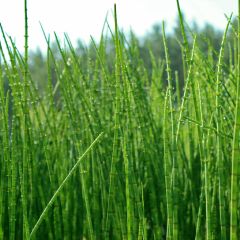
Equisetum scirpoides
- Flowering time February
- Height at maturity 20 cm
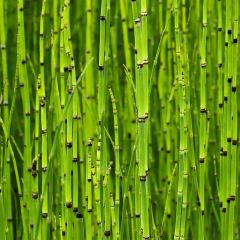
Equisetum camtschatcense
- Flowering time February
- Height at maturity 1,50 m
Discover other Equisetum - Horsetail
View all →Available in 1 sizes
Available in 1 sizes
Available in 1 sizes
Available in 3 sizes
Available in 1 sizes
Planting horsetail
Where to plant?
For exposure, horsetails will thrive if planted in full sun or partial shade.
Horsetails particularly favour moist, even waterlogged, marshy sites. They are perfect for edging ponds alongside other marginal plants. You can also plant them directly in shallow water (up to 10 cm deep). Use horsetails to green areas where soil is permanently waterlogged and other plants struggle to grow. Horsetails have advantage of preferring heavy, poorly drained soils that retain water!
Horsetails also prefer acidic, fairly fertile soils. They like clay‑loam soils but can tolerate a wide range of soils.
Horsetails are also well suited to cultivation in pots or troughs. You can place them on a patio or terrace. This makes them easy to contain while enjoying their very architectural, structural appearance. They are particularly suitable for small gardens and courtyards. Use them to hide an unsightly wall or fence by creating a “green curtain”.
When to plant?
We recommend planting horsetail in spring (April–May) or early autumn, around September–October. Plant when weather is relatively mild, avoiding periods of cold or extreme heat.
How to plant?
For planting in open ground:
- Dig a large planting hole.
- If growing them in open ground, install a rootstock barrier, as you would for bamboo! This will prevent rootstocks from spreading beyond their planting area. Also, restricting horsetail to a confined space encourages a denser clump: rather than spreading horizontally, new shoots appear among existing ones, densifying the clump and improving appearance. It is also possible to lay a large tarp at bottom of planting hole, in addition to rootstock barrier, to retain moisture and thus create a marshy medium.
- Plant your horsetails and replace substrate around them.
- Water thoroughly.
You can also plant them in pots or troughs.
- Choose a large pot and fill it with potting compost.
- Plant your horsetails, replace substrate around them and firm down lightly.
- Be sure to place a saucer under the pot to help retain moisture.
- Water generously.
Continue to water regularly, especially during first few weeks.
Finally, you can plant horsetails in a pond, in shallow water:
- Use a pot or basket, add substrate and plant horsetail in it. We do not recommend planting horsetail directly in soil, as it may become invasive.
- Position the basket under the water, avoiding submerging it deeper than 10 cm.
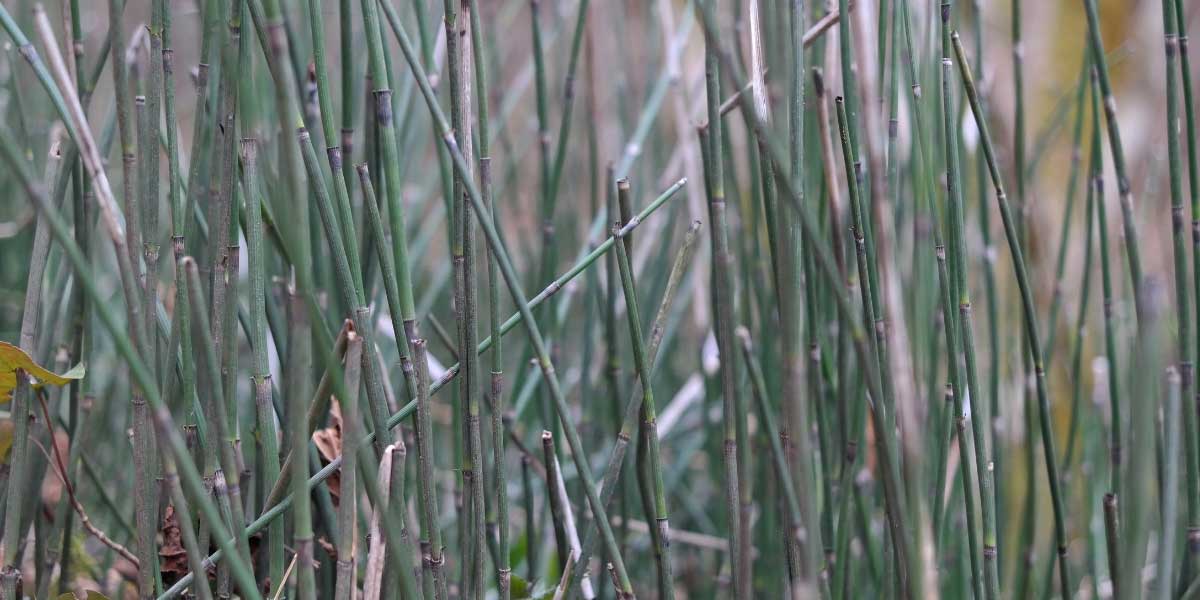
Caring for Equisetum
Most important when growing horsetails, is not to let substrate dry out, watering regularly if necessary. Be particularly vigilant if you grow them in pots, ensuring substrate stays moist even in summer.
Apart from that, horsetails do not require much care. When you see them, you can cut dead, damaged or broken stems to maintain a strong, architectural upright habit. Also keep an eye on horsetails to prevent them from spreading beyond their area and propagating… They can become difficult to eradicate. Remove any stems or rootstocks that spread outside their area straight away.
Horsetails are hardy, perennial plants that are not susceptible to pests or diseases. They also do not need fertiliser.
Propagation
Horsetails are easy to propagate by division. In theory, spore sowing is also possible, but, as with ferns, it is slow and complicated and not really worthwhile, since horsetails multiply very well by division.
Dividing clumps
To divide horsetail, best time is spring. It is also possible to do it in early autumn, but avoid periods of frost or extreme heat.
- Dig up a clump of Equisetum, or remove it from its pot (If the clump is large and spreading, you can dig up only part of it).
- Separate it by cutting the rootstocks into several pieces. Ideally, each piece of rootstock should have a few stems and roots.
- Replant each fragment in a new location, after preparing the soil. We recommend always installing a rootstock barrier, or planting in a container, to contain them.
- Water generously.
Using horsetail in gardens and at pond edges
As horsetails appreciate wet mediums, they are perfect at pond margins. You can use them to create a fairly natural area, with ferns, rushes, reeds (Phragmites australis), Acorus calamus… You can add some flowers, such as Iris pseudacorus, Lythrum salicaria or Asian primroses. Also include some true aquatic plants: water lilies, water lettuce (Pistia stratiotes), Menyanthes trifoliata, Pontederia cordata… Also discover Juncus effusus ‘Spiralis’, which bears surprising spiralled stems!
You can also view our selection of plants for ponds.
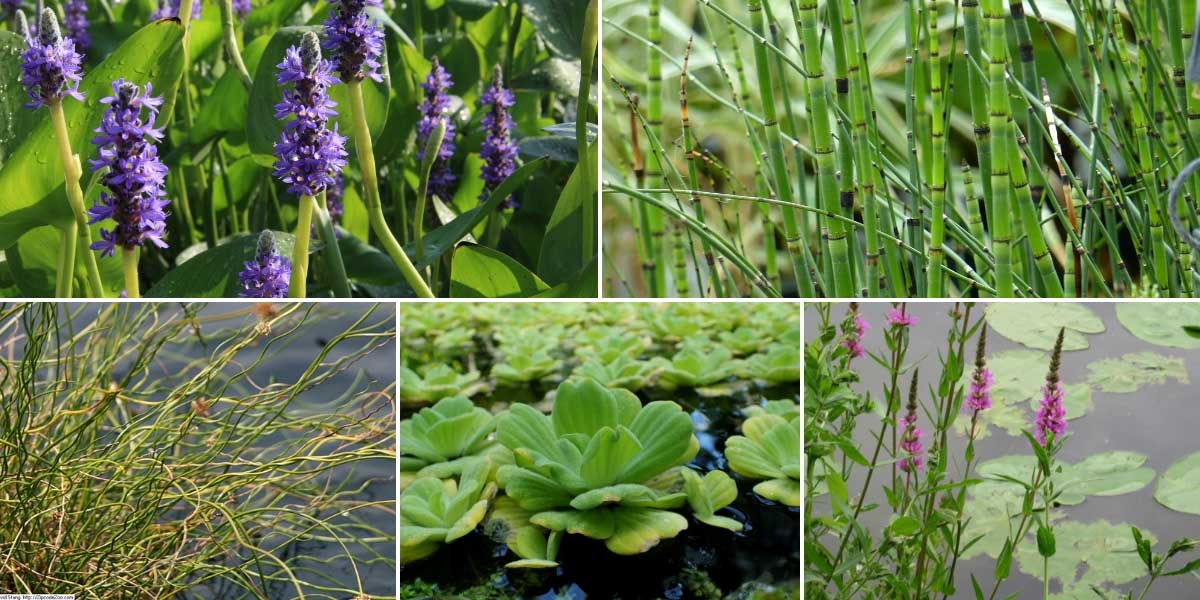
You can plant horsetails at edge of pond, with other aquatic plants and marginal plants. Pontederia cordata (photo Cephas), Equisetum hyemale, Juncus effusus ‘Spiralis’ (photo David J. Stang), Pistia stratiotes (photo Krzysztof Ziarnek, Kenraiz), and Lythrum salicaria (photo Andreas Rockstein)
With their tall, very straight stems, which generally take on beautiful green tones, horsetails fit perfectly into modern, graphic gardens (a real paradox for these prehistoric plants, so ancient!). Pair them with other plants with a graphic aspect, interesting for their silhouette or decorative foliage: Japanese maples, grasses, ferns, Ophiopogon, Hostas, Alliums, Persicaria runcinata ‘Purple Fantasy’… Also use clipped box or clipped yews. If you want to add some flowering, stick to sober shades and favour white, cream, burgundy or purple… You will achieve a garden with a timeless look.
For more ideas, you can draw inspiration from this graphic ambience.
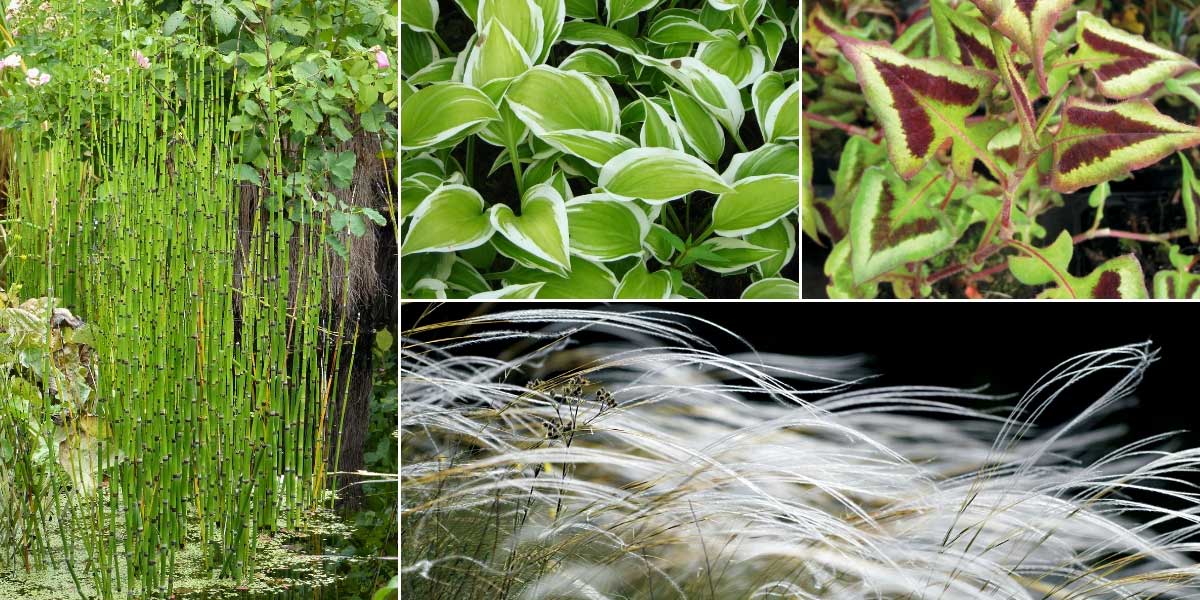
Use horsetails to compose a graphic, modern garden. Equisetum hyemale, Hosta ‘Emily Dickinson’, Persicaria ‘Purple Fantasy’, and Stipa pennata
Horsetails are also valuable for structuring borders. They provide a vertical element that immediately draws the eye and gives volume to a border. Use them to introduce contrast alongside plants with a more rounded, lower habit: alchemillas, hostas, bergenias, ophiopogons, heucheras, clipped box…
You can also plant them in a container on a terrace or in a patio, near bamboos, Hakonechloa, Imperata cylindrica ‘Red Baron’, Eucomis, agapanthus… Think also of ferns, such as Athyrium niponicum or Dryopteris erythrosora.
Finally, Equisetums can be integrated into a Japanese-inspired border. Create a zen garden by adding mineral elements, stones and gravel, then planting ferns, bamboos, Japanese maples, cloud-pruned pines, helxine, Hakonechloa, Nandina domestica, Japanese cherry trees…
Equisetums can be used to create a living screen, a separation between two spaces, or a border. They are useful for masking and hiding an unsightly wall or fence. You can create a very attractive effect by planting them in a long row, for example in a long, narrow container, to achieve a “curtain” effect. In general, horsetails should be planted in restricted, contained clumps.
Did you know?
- Medicinal properties
Particularly rich in silica, horsetail is an excellent remineralising plant that can be used for bone problems (osteoporosis, osteoarthritis, fractures…). It is also diuretic, effective against urinary disorders, and helps healing of superficial wounds. The species most used for its medicinal properties is field horsetail, Equisetum arvense. It can be used as a decoction, in capsules or as a mother tincture… Be careful, as field horsetail (Equisetum arvense) can be mistaken for marsh horsetail (Equisetum palustre), which is toxic.
- Use in the garden
Horsetail can be used in the garden as manure or decoction, effective against fungal diseases (downy mildew, rust, powdery mildew…). Field horsetail, Equisetum arvense, is harvested in June–July. It can be used curatively or preventively to strengthen plants’ defences. Manure is also effective at repelling mites, aphids and slugs.
- Traditional uses
Because of its high silica content, which gives it an abrasive character, horsetail was used to polish wood and to scour and brighten pots and pans.
Useful resources
- Discover our range of Equisetum
- To pair with horsetails, discover our selection of Perennials for damp banks
- Our video: Japanese horsetail
- Subscribe!
- Contents
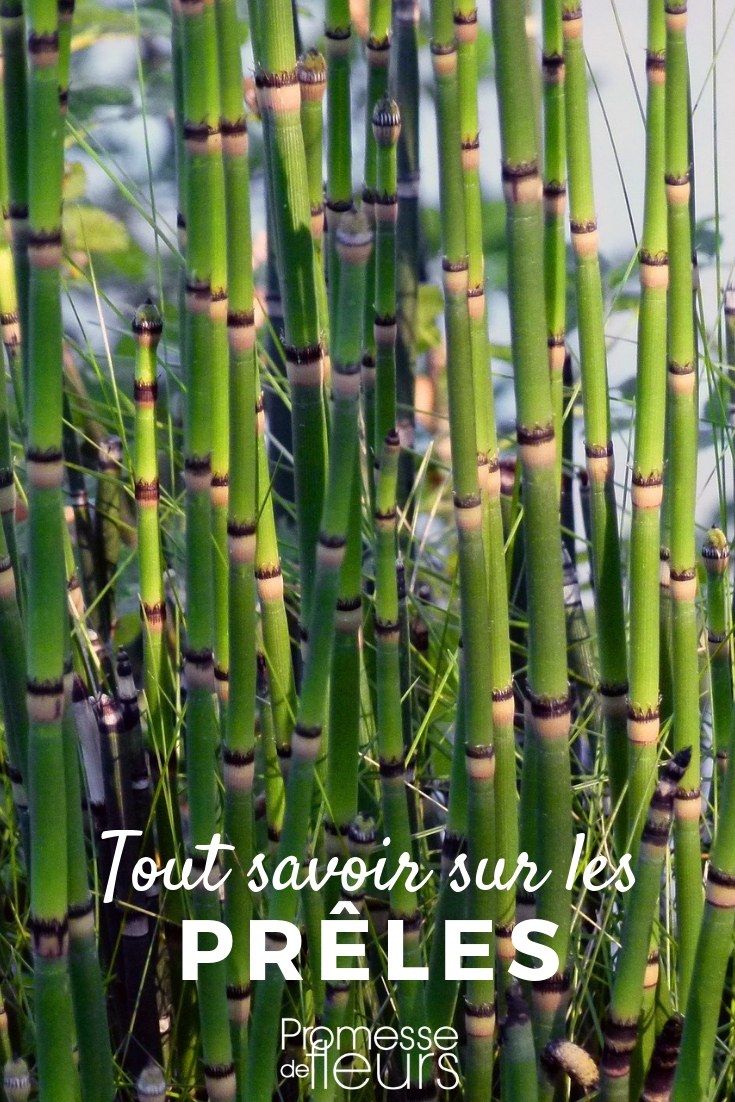



































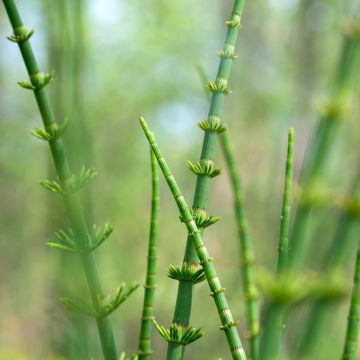
Comments